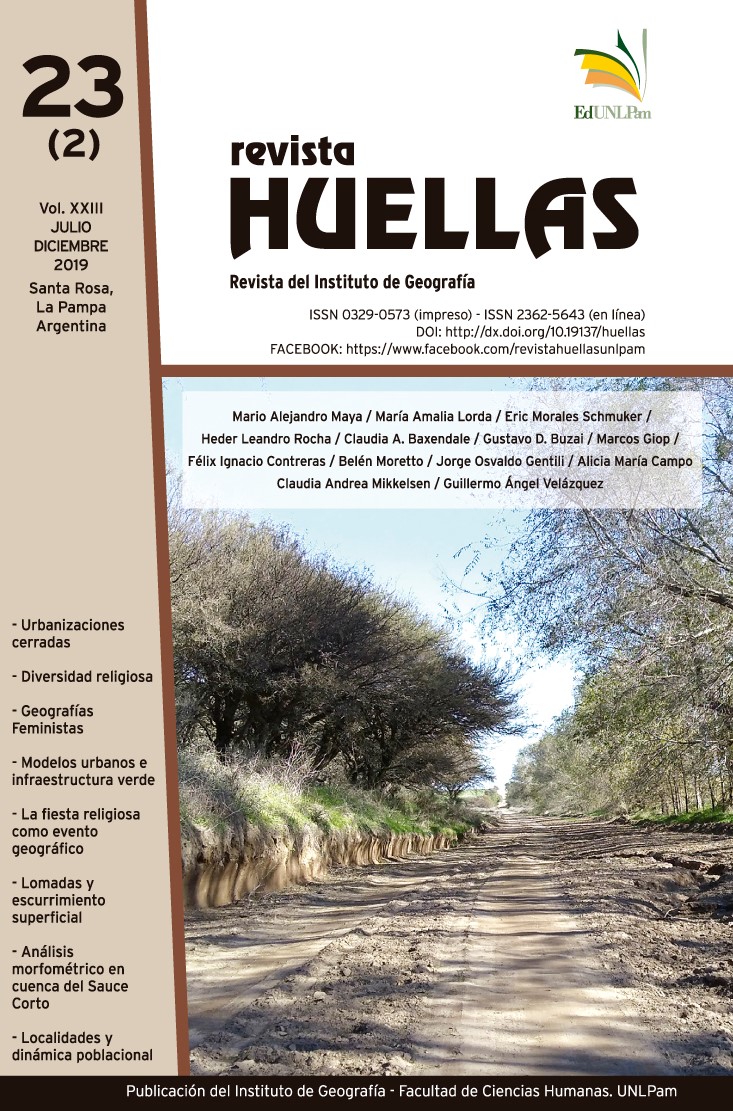“Quemando al Judas”: la fiesta como evento geográfico
Palabras clave:
Fiesta, Cultura, Pascua ColonialResumen
En la ciudad de Luján, la espacialidad cotidiana se construye con gran influencia de la esfera religiosa. Se podría pensar a la urbe misma como la principal sede del culto católico mariano a nivel nacional. Prueba de ello es que los visitantes llegan a cifras que superan el millón de personas anualmente. Si bien no es una práctica con orígenes actuales (ya desde la época colonial lujanense se registran las primeras manifestaciones), la festividad de la quema del Judas se vio atravesada en los últimos años por una nueva serie de modificaciones en torno a la morfología de sus celebraciones. En la primera década del actual siglo, el Estado municipal activó una serie de dispositivos con el principal objetivo de institucionalizar esta fiesta, para agregarla a la “agenda turística” de la ciudad. Esta situación abrió un nuevo espacio de disputas en torno a la festividad en cuestión, la cual en la actualidad es conocida formalmente como la “Pascua Colonial”. El presente artículo se propone, a través de un enfoque desde la geografía cultural, llevar a cabo una discusión teórica alrededor de las principales conceptualizaciones pensadas como herramientas para un abordaje crítico de los escenarios festivos en clave geográfica. Las categorías analíticas de escenario, territorialidad, fiesta, entre otras, son algunos de los conceptos que se consideran nodales para llevar a cabo la investigación.
Descargas
Citas
Auge, M. (1992). “Non-lieux. Introduction á une anthropologie de la surmodenité”, recuperado de :http://designblog.uniandes.edu.co/blogs/dise2609/files/2009/03/marc-auge-los-no-lugares.pdf
Christlieb, F. (2006). “Geografía Cultural” en Hiernaux y Lindón, Tratado de Geografía Humana. Pp. 220 a 253, Editorial Anthropos, México.
Claval, P. (1999). “Los fundamentos actuales de la geografía cultural”, Doc. Université de Paris-Sorbonne. Laboratoire Espace et Cultures 191, pp. 25-40, Paris.
Claval, P. (2001). Champ et perspectives de la géograpiheculturellle dix ans après Geographieetb Cultures, N° 40, Paris.
Claval, P. (2002). “El enfoque cultural y las concepciones geográficas del espacio” en Boletín de la A.G.E, ISSN 0212-9426, ISSN-e 2605-3322, N.º, Pp. 21-39, España.
Claval, P. (2014) .A festa religiosa, en Ateliê Geografico, vol. 8, Nº 1, pp. 6-29.
Coronel, D. (2017). Fiestas populares en el Conurbano Bonaerense: apropiaciones temporarias y disruptivas del espacio público en la ciudad de Berazategui desde la Muestra Anual Educativa (MAE), Tesis de licenciatura, Universidad Nacional del Centro de la Provincia de Buenos Aires, Buenos Aires.
Cosgrove, D. (2002). Observando la naturaleza: el paisaje y el sentido europeo de la vista en Boletín de la A.G.E, N° 34.
Di meo, G. (2001). La géographie en fêtes, OPHRYS, Paris.
Fradkin, R. (2000). Historia, memoria y tradición: la fiesta de la quema del Judas en Luján. Colección de cuadernos de trabajo, Departamento de Sociales, UNLu, Luján.
Luna García, A. (1999). ¿Qué hay de nuevo en la nueva geografía cultural?”, Doc. Anàl. Geogr. 34, 69-80, pp. 25-27, Barcelona.
Lindón, A. (2007). Los imaginarios urbanos y el constructivismo geográfico: los hologramas espaciales. En Revista Eure, Vol. 23, Nº99, Pontificia Universidad Católica de Chile, agosto de 2007, pp. 31-46, Santiago de Chile.
Lindón, A. (2008). De las geografías constructivistas a las narrativas de vida espaciales como metodologías geográficas cualitativas. En, Revista da ANPEGE, Vol. 4, Pp. 7-26, Porto Alegre.
Lindón, A. y Hiernaux, D. (2010). Los giros de la geografía humana –desafíos y horizontes-, Anthropos, México.
Lefebvre, H. (1991). [Original de 1974]. “The production of space”, Blackwell, Cambridge.
Lobato Corrêa, R. (2011). “Las formas simbólicas espaciales y la política”. En, Zusman, P.; Haesbaert, R.; Castro, H. y Adamo, S. (eds.) Geografías culturales. Aproximaciones, intersecciones y desafíos. Editorial de la Facultad de Filosofía y Letras de la UBA. Buenos Aires.
Eliade, M. (1956). The sacred and profane: the nature of religion. San Diego: Harcourt Brace, Jovanovich.
Massey, D. (1984). Geography matters: introduction, Cambridge University Press, Cambridge.
Schultz, U. (1993). “La fiesta. Una historia cultural desde la antigüedad hasta nuestros días”, Alianza, Madrid.
Unwin, T. (1992). El lugar de la geografía, Cátedra, Madrid.
Wagner, P. (2002). Cultura y geografía: un ensayo reflexivo en Boletín de la A.G.E, 34, pp. 41-50.
Zusman, P. y Haesbert, R. (2011). Geografías Culturales Aproximaciones, intersecciones y desafíos: introducción, Buenos Aires, Editorial de la Facultad de Filosofía y Letras, Universidad de Buenos Aires.






.png)













3.jpg)
4.png)


